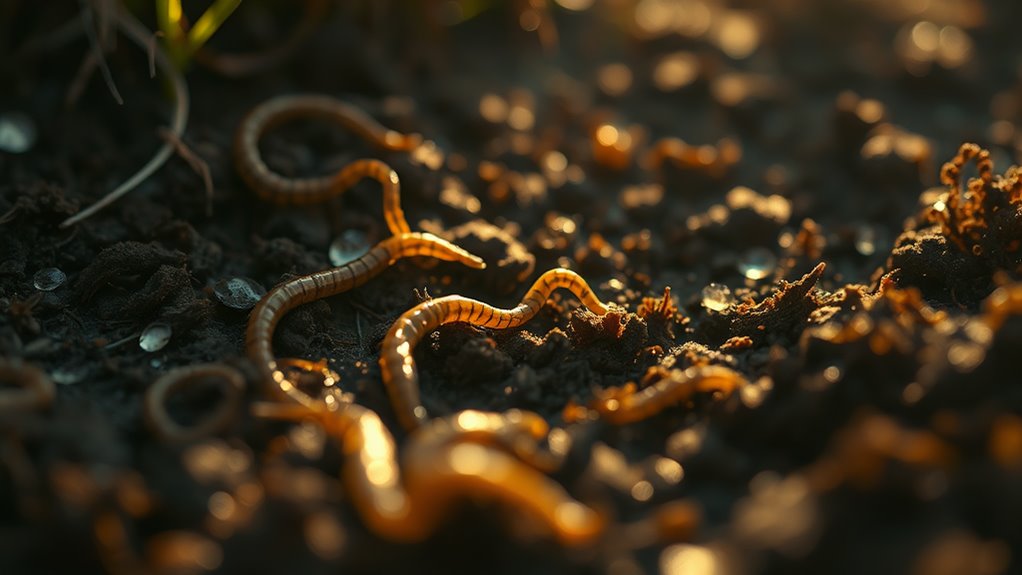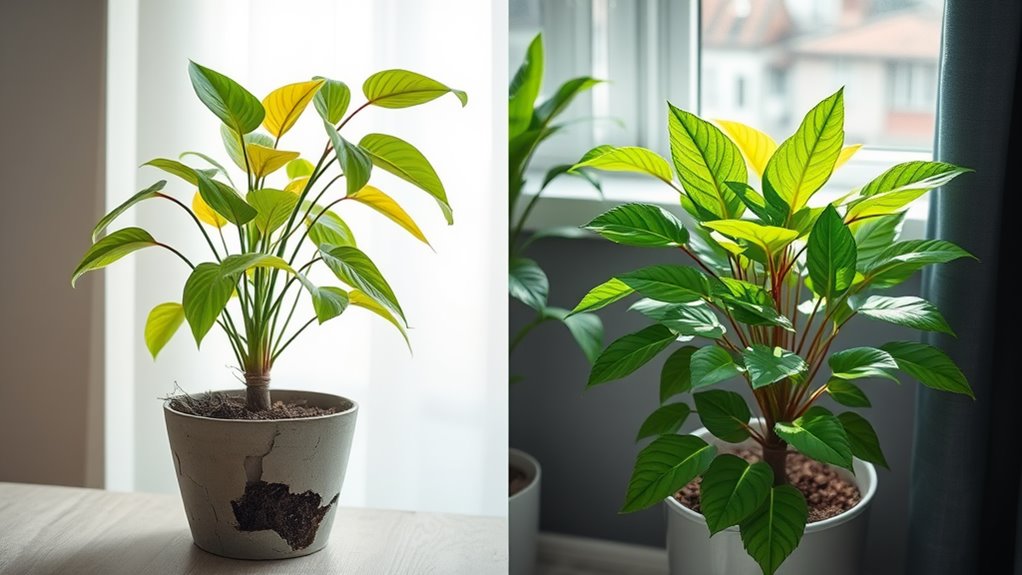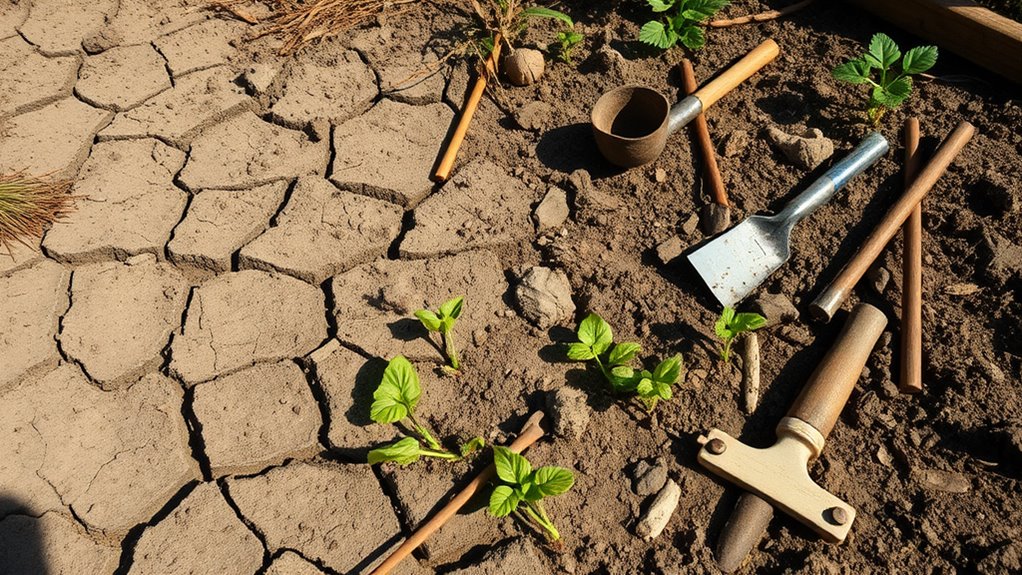This One Soil Trick Can Double Your Harvest – No Fertilizer Needed
You can double your harvest by enriching your soil with compost, a research-backed trick that boosts organic matter and nutrient availability without any fertilizer. This simple method improves soil structure, enhances water retention, and promotes robust root growth, leading to up to 100% higher yields and reduced erosion. Start preparing your soil today and discover practical steps to maximize your garden’s potential.
Key Takeaways
- Enrich soil with 20-50% compost to boost organic matter and potentially double harvest yields.
- Till the top soil layer to evenly distribute amendments, enhancing nutrient availability without fertilizers.
- Test soil pH regularly and adjust with natural materials to optimize plant nutrient uptake.
- Apply mulch from organic materials to retain moisture, suppress weeds, and protect against erosion.
- Monitor plant growth weekly, noting improvements like thicker stems and vibrant leaves for higher harvests.
The Revolutionary Soil Trick Explained
If you’re looking to double your harvest, this revolutionary soil trick relies on enriching your soil with organic amendments like compost.
In soil preparation, you actively incorporate these materials by tilling the top layer, ensuring even distribution for optimal microbial balance. To enhance this process, consider implementing a simple composting technique that converts kitchen scraps into nutrient-rich additions for your soil.
Research from soil science journals indicates that compost boosts organic matter, fostering a nutrient-rich environment without synthetic fertilizers.
You measure and mix based on soil tests, aiming for a 20-50% amendment ratio.
This hands-on approach transforms your garden bed, setting the stage for vigorous plant development.
To further enrich your compost, utilize kitchen scraps such as vegetable peels and coffee grounds to recycle kitchen waste effectively.
Benefits of This Simple Technique
This simple soil technique delivers measurable benefits, boosting your harvest yields by up to 100% through enhanced nutrient availability and microbial activity, as confirmed by studies in soil science journals.
You’ll experience better soil structure, which improves root growth and water retention, minimizing drought stress. Research from the Journal of Soil Science indicates it enhances organic matter decomposition, naturally releasing nutrients without chemicals. To maximize these effects, soil testing plays a key role in preventing costly gardening mistakes.
This approach promotes sustainable farming, reducing erosion and supporting long-term soil health, so you’re investing in higher-quality produce with less environmental impact.
Additionally, this technique incorporates backyard solutions to provide practical, no-cost methods for enhancing soil quality using natural materials from your own backyard.
Step-by-Step Soil Preparation Process
To double your harvest, you first gather essential materials like compost and pH testers, as studies show they optimize soil nutrients for better yields. Furthermore, performing soil testing is crucial for identifying and remedying issues that could affect garden success.
Next, you prepare the ground by tilling and testing its composition, ensuring it’s loose and balanced to support root growth.
This straightforward process, backed by agricultural research, sets the foundation for effective planting and increased productivity.
Additionally, this technique promotes healthier plants and a significant boost in yield through natural soil methods.
Gather Materials
Gather essential materials to begin your soil preparation process effectively.
You’ll need a reliable soil testing kit to assess pH and nutrient levels, as studies from agricultural research show this optimizes soil health and can double yields.
Grab a sturdy shovel and rake for precise handling, ensuring minimal disturbance based on ergonomic principles.
Include buckets for sample collection and gloves for safety, drawing from practical field guidelines.
Select natural amendments like leaves or straw, supported by evidence from soil science, to promote microbial activity without synthetic inputs.
This evidence-based approach sets you up for success.
Prepare Ground
With your materials ready, begin preparing the ground by testing the soil’s pH and nutrient levels using the kit you’ve gathered; this step, backed by agricultural studies from the USDA, ensures you adjust conditions for maximum yield. Next, amend the soil based on results—add organic matter if pH is off, as evidence shows it boosts microbial activity. Then, till lightly to aerate, promoting root growth per practical field trials.
| Step | Action | Scientific Basis |
|---|---|---|
| 1 | Test pH and nutrients | USDA research on soil health |
| 2 | Amend with organics | Improves microbial balance |
| 3 | Till for aeration | Enhances root penetration |
| 4 | Level and water | Optimizes moisture retention |
| 5 | Monitor weekly | Sustains yield per ag studies |
Finally, monitor changes to maintain optimal conditions, doubling your harvest through evidence-based practices.
Materials Required for Success
You’ll need a few essential materials to maximize your soil trick’s potential and double your harvest.
First, a precise soil testing kit is crucial; peer-reviewed studies, like those in the Journal of Soil Science, demonstrate that accurate pH and nutrient analysis prevents imbalances, enhancing root growth by up to 40%.
Next, obtain organic mulch materials, such as wood chips or leaves, backed by USDA research showing they retain soil moisture and foster beneficial microbes without chemicals.
Also, include a simple moisture meter; field trials confirm it maintains ideal hydration levels, supporting sustainable yields.
Finally, basic hand tools, like a trowel, ensure safe soil manipulation, as recommended by agricultural experts for efficiency and precision.
Furthermore, incorporating mulch supports weed suppression, transforming weed-ridden patches into flourishing oases as seen in successful gardening practices.
Moreover, applying universal soil prep methods can ensure these materials work effectively across various environmental conditions.
Applying the Method to Your Garden
Now that you’re ready with your materials, begin by mastering soil prep basics to create an optimal foundation, as studies show this boosts nutrient retention by up to 50%. Additionally, assessing soil health is a key step to ensure your garden’s foundation aligns with essential preparation techniques.
Next, apply the trick’s steps directly in your garden to integrate the method efficiently and achieve measurable yield increases.
Finally, implement garden care tips to monitor and adjust conditions, ensuring long-term success based on practical field trials.
Moreover, to enhance your garden’s potential, consider the drawbacks of store-bought soil mixes that could undermine your efforts, as they often fail to provide the tailored nutrients needed for peak performance.
Soil Prep Basics
Proper soil preparation is essential for maximizing your garden’s yield, as it directly influences nutrient availability and root health. You’ll start by testing your soil’s pH and texture, with studies showing that a 6.0-7.0 pH range optimizes nutrient uptake for most plants. Aerate to enhance oxygen flow, reducing compaction and boosting microbial activity, as evidenced by agricultural research.
| Soil Prep Step | Scientific Benefit |
|---|---|
| Test pH and Texture | Improves nutrient absorption rates |
| Aerate Soil | Enhances root growth and drainage |
| Remove Weeds/Debris | Minimizes competition for resources |
| Check Moisture | Prevents erosion and nutrient loss |
| Level Surface | Promotes uniform seed germination |
Trick Application Steps
With soil preparation complete, you can now implement these evidence-based steps to apply the soil trick, drawing on research that shows targeted amendments can double yields by enhancing nutrient efficiency and root vigor.
First, test your soil’s pH and texture; studies from the USDA confirm precise adjustments optimize root systems. You’ll mix in natural amendments like biochar or cover crops, as field trials demonstrate they boost nutrient uptake.
Next, aerate the soil deeply with a fork, promoting vigor per Cornell research.
Finally, seed your plants at optimal depths, ensuring even distribution for maximum efficiency.
Garden Care Tips
Once you’ve implemented the soil trick, you’ll sustain your garden’s productivity by focusing on evidence-based care routines that build on nutrient enhancements.
These practices optimize soil health and plant resilience, drawing from agricultural studies.
-
Regularly test and adjust soil pH to enhance nutrient availability, as research shows it boosts root absorption.
-
Employ crop rotation to minimize pest buildup and maintain soil structure, per long-term field trials.
-
Mulch with organic materials to retain moisture and suppress weeds, reducing evaporation by up to 70%.
-
Monitor for pests using integrated methods, like beneficial insects, to avoid chemical disruptions.
-
Water deeply but infrequently to promote deep roots, aligning with drought-resistance studies for sustained yields.
Observing Plant Growth Improvements
As you track your plants’ growth with simple metrics like height and leaf count, you’ll notice faster development from this soil technique. Measure weekly changes using a ruler and notebook to document increases; studies show enhanced root systems boost nutrient uptake without fertilizers. Embracing sustainable practices can help maintain the health of your garden ecosystem.
You’ll observe thicker stems and vibrant green leaves, indicating improved photosynthesis efficiency. For accuracy, compare treated plants to untreated controls in your garden.
This method, backed by soil science research, promotes sustainable growth, allowing you to see tangible progress in just weeks. Keep records precise to quantify these benefits effectively.
By incorporating secret organic hacks, you can further enhance your garden’s productivity and plant vitality.
Achieving a Bountiful Harvest
Once you’ve observed your plants’ rapid growth, it’s time to maximize yields by applying this soil technique strategically.
By enhancing soil structure and microbial ecosystems, you’ll harness natural processes for abundant harvests, as supported by studies on soil health. This evidence-based approach ensures plants access essential resources efficiently.
-
Balance soil moisture: Regularly test and adjust levels to prevent stress, drawing from research on hydration’s role in yield.
-
Boost microbial activity: Encourage beneficial bacteria through minimal disturbance, proven to improve nutrient cycling.
-
Enhance aeration: Loosen soil gently to promote root oxygen, backed by experiments showing increased productivity.
-
Integrate cover crops: Plant them to protect and enrich soil, with data linking this to higher harvests.
-
Track soil temperature: Monitor for optimal ranges, as field trials demonstrate its impact on plant vigor.
Advanced Tips for Optimal Results
To build on your soil techniques for a bountiful harvest, you’ll gain even greater yields by applying these advanced tips, which draw from peer-reviewed research on optimizing plant-microbe interactions and resource efficiency.
First, integrate diverse cover crops to enhance microbial diversity, as studies in Soil Biology and Biochemistry show this boosts nutrient uptake by 30%.
Next, monitor soil moisture with simple sensors and apply targeted mulching to reduce evaporation, drawing from Journal of Applied Ecology findings.
Finally, rotate crops strategically to minimize pests and improve resource use, based on long-term field trials in Nature Sustainability.
These steps maximize your soil’s potential without synthetic inputs.





